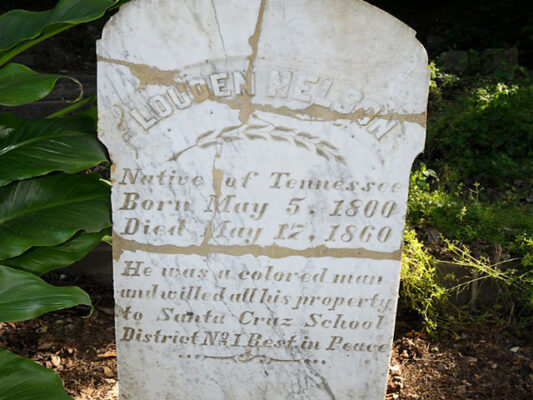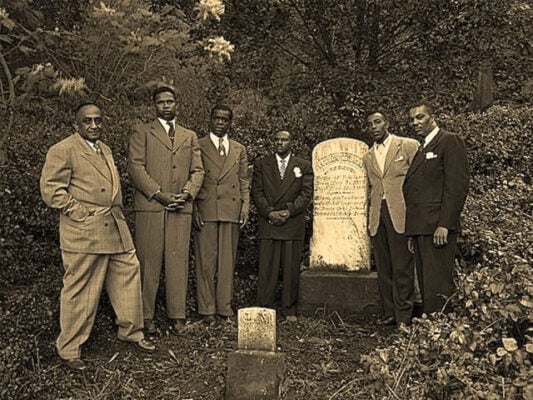Mission Street circa 1880 shot roughly from the area where London Nelson had lived and farmed two decades earlier, looking up toward Mission Hill. The handsome white building in the upper left is the Mission School, built in part with proceeds from the rental of Nelson’s property. Photo courtesy of the Santa Cruz Museum of Art and History.
How a man born into slavery became one of Santa Cruz’s most famous philanthropists
It’s a quirk of Santa Cruz history that one of the town’s best-known benefactors was misidentified for decades on the signage of the community center and plaza that bear his name. Less well known is the story of how London Nelson, born into slavery in North Carolina in 1800, came to be a free man living in Santa Cruz who bequeathed all his worldly possessions to the town school district upon his death.
Details of London Nelson’s life are scant, and not a photograph or likeness remains. But a portrait emerges from historical accounts of a smart and resourceful man who was trusted and liked by adults and children alike, and who quickly joined in community and commercial life in his adopted town, going door-to-door selling produce grown on a plot by the river near what is now Downtown Santa Cruz.
TRAVELS WITH LONDON
London reportedly came to California in the Gold Rush year of 1850 with slaveholder Matthew Nelson and another enslaved man, a 26-year-old blacksmith named Marlborough. (Many of the enslaved Nelsons were named for European cities: Paris, Cambridge, Marlborough, etc.) The Nelson party worked a gold claim on the American River over the winter of 1850-51.
For London and Marlborough, the stakes could not have been higher: the chance to buy their freedom. Apparently, the trio struck gold, because a freed Marlborough accompanied Matthew back East a couple of years later, and London, now in his early fifties, began his life as a freed man in California by investing in cobblers’ tools and traveling around the new state repairing boots and shoes.
It’s impossible to say why London chose to settle down in Santa Cruz when he visited in 1856. He became one of two Black residents, according to one account, so it wasn’t a vibrant Black community that drew him. One factor may have been that Santa Cruz was a tolerant place by the standards of the time. The local Methodist Church, which was home to a group of Abolitionists, played an important role in the town’s civic life by doubling as a school during the week. Perhaps London took stock of this situation and decided the town was a good bet.

COMMUNITY LIFE
In any event, London settled in town, leased a cabin and a 6-acre plot of land near the river where he grew onions, potatoes, and watermelons, and sold his produce from a borrowed wagon pulled by a borrowed horse.
He also joined the Methodist Church, so he was likely aware when, in 1857, the rapidly growing church located a site for a two-room schoolhouse just up the hill from his own leased land. Kids on their way to the new Mission Hill School would cross the river near London’s place. They got to know “Old Man Nelson,” and he got to know them. In 1858 the school closed due to debt, and though it reopened the next year, the closure and its effect on the kids must have made an impression on London. Over the next couple of years, London continued to work even as his health declined. One day in April of 1860, the kids he had befriended ran to tell the town doctor that London had fallen severely ill. As he lay on his deathbed a few weeks later, he left his estate — $372 including the 6 acres, which he had purchased earlier that spring — to the school district. His was one of the first graves at Evergreen Cemetery.

SETTING THE RECORD STRAIGHT
So how did this remarkable man wind up misnamed in the historical record? The answer is surprisingly mundane.
Handwriting in the 19th century was florid and fancy, with flourishes galore. And people then, as now, sometimes made mistakes, had poor eyesight, or were sloppy. After London’s death, his name began showing up in the record as “Louden” Nelson. Or “Lindon” Nelson. Or London “Neilson.” Or, strangest of all, “Shannon” Nelson. By 1890, when students at Mission Hill School — by then a four-story Italianate building, thanks in part to district income from London’s property — decided to replace the weathered wooden headstone with a lovely new marble one, the reference they looked to spell the name “Louden Nelson.” The mistake was literally etched in stone. It was then repeated many times, including in 1979, when a new community center was named for him.
The name “London” hung around, though, like a rumor, spurring speculation and research that showed that his name had, in fact, been “London.” In the summer of 2020, in the aftermath of George Floyd’s death, Brittnii Potter of Santa Cruz spearheaded a movement to correct the record and have London’s name spelled correctly on the buildings and plaques that bear his name. In June 2021 the Santa Cruz City Council voted unanimously to rename them “London Nelson,” at last correcting a wrong that had stood for far too long.
Thanks to local historians Geoffrey Dunn and Ross Gibson for their well-researched articles on this topic, and to Santa Cruz Patch for its reporting.
Find more Santa Cruz local history about local landmarks and communities past here.
